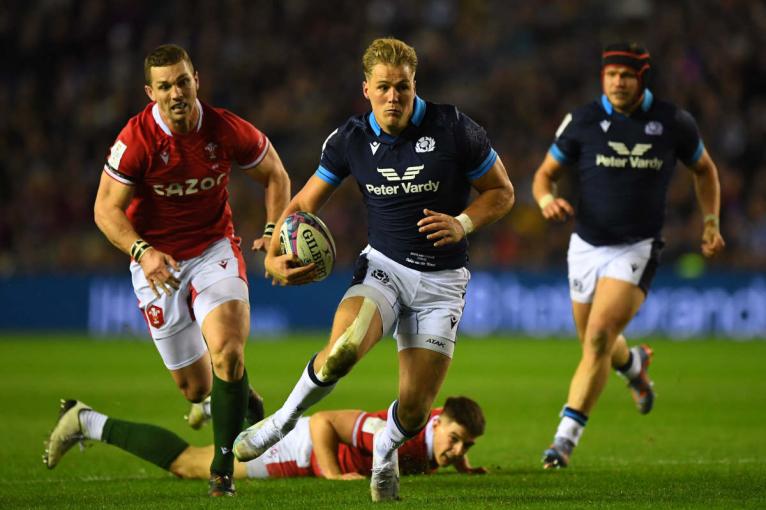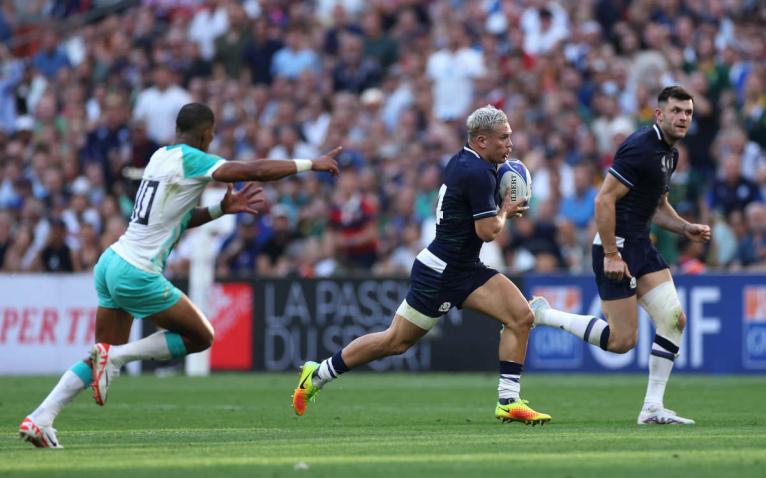It is difficult to avoid the spotlight on Finn Russell when Scotland play right now, and the fly-half’s ability to go through a wonderful box of tricks to unlock the Tongan defence, not to mention the face-to-face with Johnny Sexton in the final pool Test against Ireland, is one of the most eye-catching elements of Pool B action.
The 30-year-old Scot deserves real credit for how he has developed his all-round game, but to think that this Scotland team has become more competitive on the world stage purely because of the stand-off is to miss two things: a key area of development within the navy ranks in the past few years, and how much that has contributed to Russell becoming the player he is.
It may not yet match the southern hemisphere giants, but the try-scoring exploits of wings Darcy Graham and Duhan van der Merwe, and Stuart Hogg, the full-back who set a new all-time scoring record for Scotland of 27 – having overtaken the tally of 24 shared by Tony Stanger (from 1989-98) and Ian Smith (1924-33), in 2021 – has injected a new potency to Scotland.
There is a wave of change in Scotland’s attacking stats over the past decade that highlights the transformation that has occurred, begun under coach Vern Cotter (2013-17) and taken to another level in the last six years by Gregor Townsend. Between 2005 and 2015 Scotland were averaging 1.5 tries per game, according to OPTA stats, but in the eight years since, the rate has doubled to more than three per game.
In all, Scotland have scored 123 tries since the last World Cup and 22 players in this squad shared 97 of them, as the Scots averaged 15 different try-scorers per year. Wind the clock back to 2010 and Scotland had just five unique try scorers. They relied heavily then on world-class kickers Chris Paterson and Dan Parks who slotted goals from all parts of the pitch to keep Scotland in games, and, as competitive as they were, their failure to win games and fall to a world ranking of 12th in 2012, stemmed from the inability to cross the whitewash.

The shape of Scotland’s attacking threat a decade on is evidenced in the identity of the scorers in the past four years – 88 have come from backs, and 62 (more than half the total) from the back three alone. Russell is the chief creator, but has only notched two himself in that time (eight in all), while Van der Merwe (20) and Graham (19) are enjoying their own private race to Hogg’s tally, and will no doubt expect opportunities against Tonga and Romania in the next seven days.
Townsend is quick to state that his ambition for a more attacking game has been made possible by the quality of talent that has emerged in the past decade. There is little doubt that successful teams have good players, but, at the same time, when Scotland’s, and the global, game was one-dimensional in the early 2000s, few coaches would have picked a wing as small as Graham and there is every chance that Van der Merwe would have been lost in midfield traffic, turned into a hard-running centre, such was Scotland’s desperation then for ball-carriers that could break the gain-line.
Again, one could speculate that the change in coaching philosophy in Scotland, driven by the likes of Sean Lineen, Australian Scott Johnson, Cotter and Townsend – a quick, attacking style and modern incarnation of the ‘controlled chaos’ liked by Jim Telfer and Ian McGeechan – was a key factor. Townsend learned from Lineen, and many others around the world – he has studied Rugby League, American Football and other sports, and spent time with Pep Guardiola – and at Glasgow was strict to the point of obsession with daily drills to improve passing skills, to enable his teams to play more quickly. Improved skills shifted the dial from harem-scarem to quick and dangerous.
One glance across the Scotland back division is a sobering reminder of the challenges the country still faces in developing its own talent, with only five of the 14 backs – Graham, Russell, George Horne, Blair Kinghorn and Ollie Smith – having come through the Scottish system
He has worked with many in the SRU to develop a game style now established at youth levels, and so it is perhaps no surprise players are emerging skilled in and enthusiastic about playing fast, counter-attacking, try-seeking rugby.
But, one glance across the Scotland back division is a sobering reminder of the challenges the country still faces in developing its own talent, with only five of the 14 backs in this World Cup squad – Graham, Russell, George Horne, Blair Kinghorn and Ollie Smith – having come through the Scottish system. So, coaching of the squads has been key, and Townsend’s deep-seated belief in a Scotland team taking risks, running ball from deep and counter-attacking – and effective global recruitment – is at the heart of it. He has been helped immeasurably by a succession of assistant coaches bringing structure, experience and forward consistency to the mix.
And the timing was impeccable for Russell. Into that changing philosophy came a confident, skilful player in the mould of Townsend; daring, bold, ambitious and with a sharp rugby brain. Russell benefited from Glasgow’s growth into a Celtic and European contender, an, conversely, the Warriors grew confidence from having a talismanic ‘Zorro’ spearheading their attack through that era.

He had and he sharpened a variety of weapons outside him. At Glasgow, sniping scrum-half Ali Price found his feet, and adopted some Glaswegian gallusness as Russell’s flatmate, and Scots-born Englishman Huw Jones flew in from South Africa and immediately started ripping open European defences. After two tries on his Murrayfield Test debut, against Australia, the centre scored against England, Samoa, New Zealand, the Wallabies again, France and England again inside 18 months. That he had a couple of years in the Test wilderness remains an oddity, but also points to the emerging alternatives around him.
Alongside Jones the Glasgow back division was picked from Mark Bennett, Alex Dunbar, Sam Johnson, Sean Lamont, Tommy Seymour and Lee Jones – all different but potent finishers – and throw in Fijians Niko Matawalu and Leone Nakarawa, and at one stage Taqele Naiyaravoro, and Russell had more attacking options than any predecessor. With a coach urging him to play “what you see”, well, why wouldn’t you?
Finn Russell had the desire and players around with the speed and ambition to follow his lead. A magician with all the cards.
Racing 92 liked what they saw and signed Russell in 2018 and, following none other than Dan Carter, he found himself surrounded by greater riches in rugby’s version of the ‘Galácticos’. Again, he was encouraged to play an entertaining brand of rugby, by club owner Jacky Lorenzetti, coaches and world-class finishers like Simon Zebo, Teddy Thomas, Juan Imhoff and Virimi Vakatawa. Again, why would he not keep pushing the boundaries, practise his sleight of hand and different kicking options, and keep attacking the line and inviting defences to him? He had the desire and players around with the speed and ambition to follow his lead. A magician with all the cards.
Back with Scotland, Ben White stepped up as an astute deliverer of ball at scrum-half, but also a sharp attacking threat, while Sione Tuipolotu found his feet, while leaving others reeling on theirs, as a foil for Jones in midfield. Chris Harris showed sufficient quality to earn a British and Irish Lions jersey in 2021, but he can’t get the navy 13 back due to Jones’ superior finishing skills, while youngster Cameron Redpath sprang into the Test arena with a fine debut in Scotland’s first victory against England at Twickenham in 38 years, yet knows he must also bide his time. Glasgow wing Kyle Steyn has scored nine tries in 13 Tests, and yet accepts that even if he finishes another few against Tonga he still may not start against Ireland.

Edinburgh’s Blair Kinghorn bid his time while Stuart Hogg was in residence at full-back, playing on the wing and at stand-off, and still managed seven tries in his first 17 Test matches. It is rare for Scotland supporters to lose a player of Hogg’s quality and, instead of plummeting into mourning, feel excited by the successor. Kinghorn has achieved that with already 47 caps to his name, and some sublime finishes in his 13 tries to date. And then of course you have the very different skill-sets of Graham and Van der Merwe, which have flourished under Townsend, and given Russell potent options coming off either shoulder.
The Scots are making more carries, eating up way more metres, evading more tackles and beating double the number of defenders of a decade ago, but one thing doesn’t change: the final result is what counts.
The fly-half has riches that no Scotland 10 before him has enjoyed. Herbert Waddell had bright stars outside him in GPS Macpherson, Johnnie Wallace and Ian Smith, in the 1925 Grand Slam team, and John Rutherford similarly enjoyed looking for David Johnston, Keith Robertson and Roger Baird in the 1984 Slam side, as did Craig Chalmers with Lineen, Scott and Gavin Hastings and Tony Stanger outside him in 1990. Townsend’s Five Nations winning back-line of 1999, including Gary Armstrong, John Leslie, Alan Tait and Glenn Metcalfe, was special too. But, while one can debate the relative strengths across the full teams, none had the pace and proven try-scoring ability in so many, as the current Scotland back division.
The caveat is that we are only comparing Scotland teams with Scotland teams, and none of that guarantees that they will qualify from the toughest of World Cup pools in 2023. They have doubled their try rate, but the total number of points scored per Test match has not changed much in the last decade and is actually down on 2016-2019. The Scots are making more carries, eating up way more metres, evading more tackles and beating double the number of defenders of a decade ago, but one thing doesn’t change: the final result is what counts.

It is to Scotland’s significant benefit that Townsend and Russell got themselves back on the same page in the past year, but as much as they need each other, this squad needs to exploit an unprecedented armoury of attacking threats if they are to bounce back from the opening defeat to South Africa and take this ‘Group of Death’ to the wire.


Let's hope for Scotland they make it through.